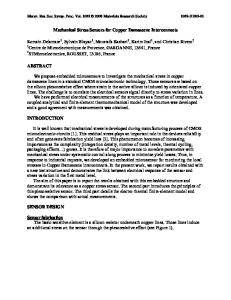High Density Plasma Silicon Carbide as a Barrier/Etch Stop Film for Copper Damascene Interconnects
- PDF / 403,494 Bytes
- 6 Pages / 612 x 792 pts (letter) Page_size
- 7 Downloads / 347 Views
HIGH DENSITY PLASMA SILICON CARBIDE AS A BARRIER/ETCH STOP FILM FOR COPPER DAMASCENE INTERCONNECTS Hichem M’Saad, Seon-Mee Cho, Manoj Vellaikal, Zhuang Li Applied Materials, Inc. Dielectric Systems and Modules Santa Clara, CA 95054 ABSTRACT A low κ dielectric barrier/etch stop has been developed for use in copper damascene application. The film is deposited using methane, silane and argon as precursors in a HDPCVD reactor. The film has a dielectric constant of 4.2 which is lower than the dielectric constant of conventional SiC or plasma silicon nitride (>7). Film characterization including physical, electrical, adhesion to ILD films, etch selectivity, and copper diffusion barrier properties show that this film is a better barrier than silicon nitride for low κ copper damascene interconnects. This film consists of a refractive index in the range of 1.7 to 1.8, a compressive stress of 1.0-1.5x109 dynes/cm2, and a leakage current of 5.0x10-10 A/cm2 at 1 MV/cm. When integrated in-situ with HDP-FSG, an effective dielectric constant of 3.5 can be achieved. INTRODUCTION In copper dual damascene interconnects, the dielectric material is embedded with a copper diffusion barrier and an etch stop. In first generation copper damascene devices, the barrier is usually silicon nitride because of its good barrier properties to copper diffusion, its selectivity to oxides, its good dielectric strength, mechanical and chemical stability, and electrical insulation. However, silicon nitride suffers from a high dielectric constant, around 7.2. This high dielectric value increases the overall ILD time delay (Figure 1). Therefore, there is a need to substitute silicon nitride with a lower dielectric constant barrier, especially for the lower dielectric constant materials. Indeed, Table 1 shows that substituting SiN with a lower κ barrier (κ=4.2) reduces the effective κ by 17% in conjunction with black diamond but by only 12% in conjunction with silicon oxide. Therefore, we have embarked on developing a lower dielectric constant barrier which can be used in combination with low κ materials in Cu interconnects. Table 1: Effective Dielectric Constant for different IMD schemes in copper damascene interconnects
ILD κ Value BD USG FSG κ=4.1 κ=3.3 κ=2.7
Barrier κ Value 1,000Å SiN (κ = 7.2)
1,000Å HDP-SiC (κ = 4.2) D9.14.1
4.7
4.2
3.6
4.1
3.5
3.0
Effective Dielectric Constant
5.5 5.0 4.5 4.0 3.5
10
A 00
SiN
3.0 2.5 2.0 2.0
(k =
7 .2
)
0 10
0A
P HD
SiC
(k =
4 .2
)
Oxide (κ=4.1)
HDP-FSG (κ=3.3) Black Diamond (κ=2.7)
2.5
3.0 3.5 4.0 4.5 ILD Dielectric Constant
5.0
Figure 1: Barrier impact on effective dielectric constant for a 400nm ILD and a 100nm barrier. Data was generated by assuming that the barrier and low k material form a parallel plate capacitor. Black Diamond is a carbon-doped oxide low κ material [1-4] while HDP-FSG is a fluorine-doped oxide [5].
THEORY Silicon carbide is known to exhibit excellent etch resistance to fluorine chemistry. Hence, SiC would be an ideal etch stop because it would provide good sel
Data Loading...





